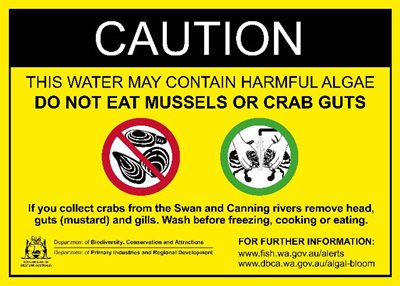Alexandrium Bloom
Following two consecutive years of significant Alexandrium blooms impacting recreational and commercial fishing in the Swan and Canning Rivers, the Department of Primary Industries and Regional Development (DPIRD), Department of Biodiversity, Conservation and Attractions (DBCA) and the Department of Health (DoH) have decided on a new management approach.
The new approach involves the installation of caution signage at various locations around the river advising against eating mussels or crab viscera/stomach.
An example of this signage is below:

Caution signs have been placed at the following locations:
- Claughton Reserve jetty
- Hinds Reserve jetty
- Katanning Street jetty
- Memorial Drive boat ramp;
- Bath Reserve foreshore and jetty
- East Street Maylands Yatch Club and
- Maylands boat ramp.
Please see the Department of Biodiversity, Conservation and Attractions website for further information and updates.
Karlodinium Bloom
The Department of Biodiversity, Conservation and Attractions (DBCA) advises that levels of the harmful algae (Karlodinium) have recently decreased in the Swan River. However other red-tide forming nuisance species have replaced it. The algae, which can cause a reddish-brown water discolouration are impacting the Swan River near Ascot Marina and from Guilford to Middle Swan Bridge, as well as the Canning River from Riverton to Kent Street Weir.
DBCA officers are continuing to monitor the blooms and will keep our key Riverpark stakeholders updated.
Information from members of the public is welcome. Anyone who sees dead or sluggish fish in the Swan and Canning Rivers are asked to report this to FishWatch on 1800 815 507. The public are reminded to follow Department of Health advice and avoid waters that appear discoloured, murky or smell unpleasant over the Australia Day long weekend.